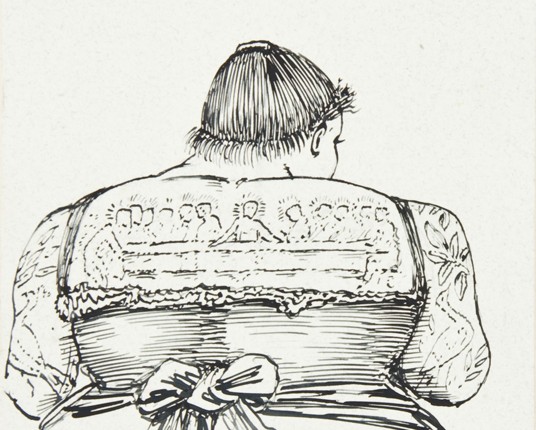
An American presidential candidate recently used the term “binders full of women” in a political debate. The evocative nature of the term, above and beyond the intent of the candidate, inspired many an Internet howler for the American public, but I’d like to explore the term from a collections perspective. Archival collections do, sometimes, contain what we might call “binders full of women.”
One example at the Clark Library is a set of two bound albums of letters and drawings by Edward Burne-Jones and newspaper clippings, dating approximately 1892-1897. Burne-Jones sent these letters and drawings to Violet Maxse (later, Viscountess Milner) while she was in her early 20s. Milner, born in 1872, was the daughter of Burne-Jones’s friend, Cecilia Steele Maxse, and later became an imperial activist and editor of the National Review. Milner entitled her albums “Notable Women of the Day,” using letters cut from magazines and newspapers. In them, she compiled the letters and drawings she received from Burne-Jones along with multiple images, clipped from newspapers, of various women, often suffragettes portrayed as stuffy or severe.

These are rather eclectic binders full of women, but they do have specific foci that reflect Milner’s social perspective and position in society.
Burne-Jones’s letters often include whimsical drawings, from hairy sprites pulling on trousers to caricatures of himself in bed with influenza, but many feature women’s faces and bodies. Some seem to be general studies of heads or movement while others feature specific individuals.

One such individual is tattooed lady Emma de Burgh, whose upper back is emblazoned with an image of the Last Supper. de Burgh toured Europe in the late 19th century and the Last Supper tattoo was one of her best-known features. Burne-Jones was drawing a woman who was known for being drawn…upon.

Another individual illustrates the text of a letter, in which Burne-Jones asks if Milner’s sister, Olive Maxse, has told Milner about her horse. The drawing gives us the impression that Olive Maxse was quite the mistress of a fine, oversized hobby-horse and, perhaps, not to be trifled with.

There are myriad fascinating drawings in these albums and I encourage anyone who is interested to visit the Clark to have a look and think about what impact these binders full of women might have on our understanding of England in the 1890s as well as the kinds of howlers they provided for Burne-Jones, Milner, and their friends.


Great title!